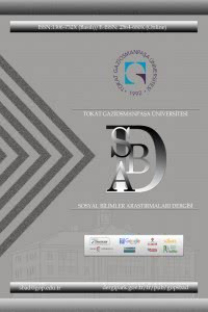İnternete Dayalı Araştırmalarda Eleştirel Düşünme Sorunsalı: 21. Yüzyıl Skolastiğine Doğru
Geçtiğimiz yirmi yılda, sunduğu pek çok kolaylık ve basılı kaynaklarda veya bir kütüphane ulaşılması mümkün olmayacak genişlikte veri sunması nedeniyle, internet temel araştırma ve bilgiye ulaşma aracı haline gelmiştir. Bununla birlikte, basılı kaynaklarda yayın öncesi editör ve hakem denetimleri yapılarak bilgilerin doğruluğu denetlenirken, bir özgürlük alanı olarak kabul edilen internet kaynaklarının çoğunda böyle bir denetimin söz konusu olmaması, kontrol edilemeyecek sayıda sitenin olması, sitelerin bilimsel amaçların yanı sıra reklam, manipülasyon, dezenformasyon ve ideolojik vb. amaçlarla kurulması, öğrencilerin geleneksel olarak pasif bir öğrenme kültürüne sahip ve eleştiriden ziyade kabul etme eğiliminde olması gibi nedenlerle internette yapılan araştırmalar, kanıt ve gerekçelerin aranmadığı, eleştirel bir gözle inceleme yapılmayan ve olgular karşısında doğruluklarını sınama gereksinimi duymadan bir otoritenin görüşüne bağlanma şeklinde tanımlanabilecek olan skolastik düşünme biçimine dönüşmektedir. Bu durum ise başta eğitim sisteminin eleştirel düşünen, sorgulayan, bilimsel tutuma sahip olan öğrenci yetiştirme amacını tehlikeye düşürmektedir. Bunun için bu çalışmada, öğrencilerin sahip olması gereken eleştirel düşünme becerileri, internette yapılan araştırmaların temel özellikleri, web sitelerinin sunduğu avantajlar ve olası tehlikelere değinilecek ve çalışmanın sonunda web kaynaklarına sorgulayıcı bir bakış açısı ile incelemen ve eleştirel bir değerlendirmeden geçirebilmek için gereken bir takım ölçütler önerilecektir
Anahtar Kelimeler:
İnternet, eleştirel düşünme, skolastik, bilgi
Critical Thinking Problem in Internet Based Research: Towards 21. Century Scholastic
The last two decades, internet became a main research tool, since it provides a lot of facilities and wide range of information which is imposible to access with other types of information resources. However, while referees and editors monitoring and controlling published resources, internet being accepted as a freedom area does not include such a systematic control. First of all, there are too many sites to control and these sites are designed for the aims of advertising, manipulating, giving disinformation and imposing idelogies besides their scientific aims. Moreover, taking into consideration the fact that students have passive learning culture traditionally and they are in the tendency of accepting instead of criticisizing, the researches which are done in the internet are turned into a kind of scolastic thinking way which can be defined as being devoted to the views of an authority without the need to test the reliability, without seeking the proofs and reasons and conducting the observations with a critical perspective. This situation threatens the aim of educating a student who thinks critically, who questions and who has a scientific attitude. Therefore in this study, the critical thinking skills that the students need to have, the main features of the research done in the internet, the advantages that web sites serve and the possible dangers will be described. At the end of the study, to investigate and evaluate critically, some criteria will be suggested
Keywords:
Internet, critical thinking, scholatic, knowledge,
___
- Bakioğlu, A. ve Hesapçıoğlu M. (1997). Düşünmeyi Öğretmekte Öğretmen ve Okul Yöneticisinin Rolü: Düşünmek. Marmara Üniversitesi Atatürk Eğitim Fakültesi Eğitim Bilimleri Dergisi, 9.
- Beyer, BK. (1988). Developing a Thinking Skills Program
- Boston: Allyn & Bacon.
- Browne, M. N.; Freeman K. (2000). Distinguishing Features of Critical Thinking Classrooms, Teaching in Higher Education, 5, (3).
- Browne, M. N.; Freeman K. Willamson, E. Carrie L. (2000). The Importance of Critical Thinking for Student Use Of The Internet, College Student Journal, 9.
- Chance, P. (1986). Thinking in the Classroom: A Survey of Programs. New York: McGraw-Hill.
- Darnton, R. (1999). No computer can hold the past. The New York Times. A25.
- Delphi Report. (1990). “Critical Thinking, A Statement of Expert Consensus for Purposes of educational Assessment and Instruction”. [Online] Retrieved on 12-January-2007, at URL: http://www.insightassessment.com /dex.html.
- Ennis, R.H. (1985). A logical basis for measuring critical thinking skills, Educational Leadership, 43, 2, 45–8.
- Iseke-Barnes, J.M. (1996). Issues of educational uses of the Internet: power and criticism in communications and searching. Journal of Educational Computing Research, 15(1), 1-23.
- Kurfiss, Joanne Gainen. (1988). Critical Thinking: Theory, Research, Practice, and Possibilities. ASHE-ERIC Higher Education Report. No.2. Washington: ASHE-ERIC.
- Lenhart, A. Maya S., Graziano M. (2001). The Internet and Education: Findings of the Pew Internet & American Life Project, Washington.
- Norris, P. S. (1985). Syntesis of Research on Critical Thinking, Educational Leadership, 42,8.
- Özden, Y. (1998). Öğrenme ve Öğretme, Ankara: Pegem Yayıncılık.
- Rothenberg, D. (1997). How the Web destroys the quality of students' research papers. The Chronicle of Higher Education, 43(49), p.A44.
- Scherer, K. (1997). College life on-line: healthy and unhealthy Internet use. Journal of College Student Development, 38(6), 655-65.
- Silva, M.; Cartwright, G.F. (1993). The Internet as a medium for education and educational research. Education Libraries, 17(2), 7-12.
- Sorapure, M., I.; Yatchison, P. G. (1998). Web literacy: challenges and opportunities for research in a new medium. Computers and Composition, 15(3), 409-424.
- Thome, R. (1996). The fourth R is research. Electronic Learning, 16, 58.
- Ünder, H. (2002). Skolastik Eğitim ve Türkiye’de Skolastik Tarz. Ankara:Epos Yayınları.
- Walters, K. S. (1986). Critical Thinking in Liberal Education: A Case of Overkill? Liberal Education. 72(3).
- ISSN: 1306-732X
- Yayın Aralığı: Yılda 2 Sayı
- Başlangıç: 2006
- Yayıncı: Gaziosmanpaşa Üniversitesi Sosyal Bilimler Enstitüsü
Sayıdaki Diğer Makaleler
Okul Kültürü İle Öğrencilerin Şiddete Başvurma Davranışları Arasındaki İlişkiler
Mehmet Metin ARSLAN, Harun BAHADIR
İnternete Dayalı Araştırmalarda Eleştirel Düşünme Sorunsalı: 21. Yüzyıl Skolastiğine Doğru
Sanayi Toplumundan Sanayi Sonrası Topluma Farklılaşan Gençlik Hallerinin Sosyolojik Görünümü
Sanal Platformların Lisansüstü Eğitimde Kullanımı: Türkiye Perspektifi
Kerem KILIÇER, Ahmet Naci ÇOKLAR
Tarihi Gelişim Sürecinde Keman
İkincil Yazının Oluşmasında Eleştirmenlerin Rolü Üzerine
Bilim ve Sanat Merkezlerinde (BİLSEM) Görev Yapan Öğretmenlerin BİLSEM’e Yönelik Görüşleri
